Sound Blaster Live!
Sound Blaster Live! is a sound card from Creative Technology. It is a PCI add-on board for PCs.
Overview

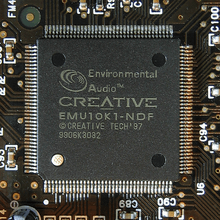
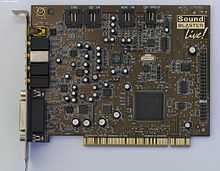
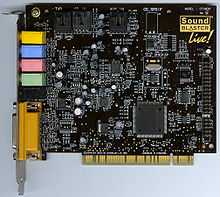
Sound Blaster Live! (August 1998) saw the introduction of the EMU10K1 processor, a 2.44 million transistor audio DSP, rated at 1000 MIPS. The EMU10K1 featured hardware acceleration for DirectSound and EAX 1.0 and 2.0 (environmental audio extensions), a high-quality 64-voice MIDI sample-based synthesizer, and an integrated FX8010 DSP chip for real-time digital audio effects.
A major design change from its predecessor (the EMU8000) was that the EMU10K1 used system memory, accessed over the PCI bus, for the wavetable samples, rather than using expensive on-board memory. This was possible at this point because systems were being equipped with far more RAM than previously, and PCI offered far faster and more efficient data transfer than the old ISA bus.
The integrated FX8010 was a 32-bit programmable processor with 1 kilobyte of instruction memory. It provided real-time postprocessing effects (such as reverb, flanging, or chorus). DSP effects in the older SB/AWE family were restricted to MIDI synth, but in the SB/Live family, the EMU10K1's integrated FX8010 operated on any source. This capability let users select a pre-defined listening environment from a control-panel application (concert hall, theater, headphones, etc.) It also provided hardware-acceleration for EAX, Creative's environmental audio technology. The Effect algorithms were created by a development system that integrated into Microsoft Developer Studio. The effects were written in a language similar to C, and compiled into native FX8010 object code by its compiler, fxasm.
The Sound Blaster Live! featured higher audio quality than previous Sound Blasters, as it processed the sound digitally at every stage, and because of its greater chip integration that reduced the analog signal losses of older, larger cards. Unfortunately, digital processing brought some limitations. The DSP had an internal fixed sample rate of 48 kHz, a standard AC'97 clock, meaning that the EMU10K1 always captured external audio-sources at the 48 kHz, then performed a sample-rate conversion on the 48 kHz waveform to the output the requested target rate (such as 44.1 kHz or 32 kHz). This rate-conversion step introduced intermodulation distortion into the downsampled output. The SB/Live had great difficulty with resampling audio-CD source material (44.1 kHz) without introducing audible distortion. Creative addressed this concern by recommending audio-recording be performed exclusively at 48 kHz, and use third-party software to handle the desired sample-rate conversion, to avoid using the EMU10K1's sample-rate conversion.
Sound Blaster Live! supported multi-speaker output, initially up to a 4-speaker setup. The software referred to this as a "4.1" setup, meaning 4 satellites and a subwoofer. While this is the case, the subwoofer is not on a separate output as it is with 5.1 and higher audio. Instead, a low-pass filter (crossover) within the speaker system removes high and midrange frequencies from the sound card's output for the subwoofer. Games see a "4.1" speaker system as quadraphonic because DirectSound itself offers no subwoofer output in this configuration. This is not limited to Creative sound cards; Aureal, Ensoniq, Philips, and other manufacturers have made cards that use four-speaker output in the same fashion. Later versions of the Live!, usually called Live! 5.1, offered 5.1-channel support which adds a center-channel speaker and LFE subwoofer output, most useful for movie watching where Dolby Digital 5.1 is decoded.
The Live! implemented DOS legacy support via Ensoniq's AudioPCI DOS TSR program. Creative acquired Ensoniq in 1998 and, as part of the deal, made use of this highly-compatible ISA sound card emulator with their newer cards. In fact, the Live! uses ".ecw" (Ensoniq Concert Wavetable) files for the wavetable emulation in DOS. The program enables support for many standards, such as Sound Blaster 16, General MIDI, AdLib (OPL3), among others.
Sound Blaster Live! was the first sound card from Creative with the "What U Hear" recording input channel. This was supported in the Windows drivers, so no additional software was needed to utilize it. The analog stereo audio signal that came out of the main Line Out was directed into this input. That way, one could mix all available inputs and the MIDI synth into one stereo signal. When using "What U Hear" with 5.1 sound, the sound would be downmixed to stereo first. The Creative Recorder utility included with the sound card was specifically designed to take advantage of the "What U Hear" feature, making it a simple matter to capture streaming sound from any source, even from programs that deliberately avoid providing a means for saving the digital sounds, thus freeing non-technical users from the complexities of "patching" between inputs and outputs of various software modules.
Design Shortcomings
[citation needed] The original SB Live! had a very low noise floor for its time; however, a critical design flaw limited its application in quadraphonic audio. The two S/P-DIF channels that each provided a stereo pair differed in their Digital to Analog reconstruction. Since the AC'97 chip provided an internal 48 kHz DAC, Creative chose not to implement two identical DAC pipelines, and the front-speaker audio pair was subjected to a different reconstruction and amplification regime to that of the rear channel (as evidenced by differently valued pull-up resistors and filter-capacitors in the area forward of the AC'97 chip, in the specifications of the AC'97 itself, and in the use of different amplifier Op-Amps).
The rear channel was serviced by a separate, but arguably better Philips UDA1334 DAC, yet the Op-Amp used to boost the signal to output levels had a noticeably different frequency response envelope that was not normalized to the front channel, leaving a "thin and quiet" rear channel. To make matters worse, the rear channel Op-Amp was of the inverting variety without being treated as such, leaving the rear speakers out of phase with the front, requiring switchover. These problems were not encountered by those using the Gold editions' daughterboard 4-speaker digital-output, but the tendency of the AC'97 chip to fail when used as an input source to medium-impedance musical instruments removed the use of the front channels altogether, although the chip could be sourced from cheaper AC'97 compatible products and soldered into place. Nevertheless, simply redirecting front signal to rear output of SB Live! was for a long time a favorite trick for computer audio enthusiasts who want better sound for minimum of money.
Despite these problems, the original SB Live! can still be used well as a S/P-DIF input/output and MIDI input/output device for network-connected digital audio workstation environments.
Models
Sound Blaster Live! and Live! Value

The Live! and Live! Value are the original releases of the Live! family.
The Live! Value (also known as Live! 1024) is identical to the full Live! with the exception that it has color-coded plastic connectors instead of gold and does not include the extended digital I/O card. The original Sound Blaster Live! had a proprietary 9-pin mini-DIN connector for digital output that Creative referred to as the "Mini Din." This connector allowed the use of a microphone and digital speakers at the same time. This cannot be done with the value and base models of all subsequent Creative sound cards, as they share a single port for S/PDIF digital in/output and microphone connectivity. The Mini-DIN connection was not included in any subsequent Sound Blaster product, however owners of speaker systems that use this as the only digital input may buy an adapter from Creative.
Unfortunately the card is not supported by Windows Vista unless running the sound in the 5.1 surround sound setting. [citation needed].
An outside party has released free drivers for the sound card here: http://kxproject.com/
For details on the original Live! including the Gold edition, marketing strategy, and design faults, see Sound Blaster Live! (Original)
-
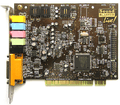
Creative Sound Blaster Live! 1024 soundcard upper view (chips)
-

Creative Sound Blaster Live! 1024 soundcard side view (connectors)
-
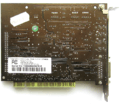
Creative Sound Blaster Live! 1024 soundcard back view (soldering)
-

Creative Sound Blaster Live! 1024 soundcard 3D view with chips
-

Driver CD of Sound Blaster Live! 1024 sound card
Sound Blaster Live! Platinum
Released 1999 Includes Live! Drive IR
Sound Blaster Live! 5.1 and Sound Blaster Live! Platinum 5.1
Released 2000. Live! with added outputs for a center channel speaker and LFE subwoofer channel.
Sound Blaster Live! Dell OEM
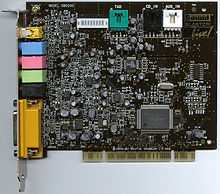
This card, marketed as a Sound Blaster Live!, did not have the full capabilities of the retail versions of Live! It used a different audio chip, not EMU10K1 but EMU10K1X, that is noticeably smaller with fewer pins. The chip does not accelerate DirectSound in hardware, nor EAX. The sale of this board by Dell created some controversy because it was not obviously marketed as an inferior or cheaper product. The card can be identified by its part number (SB0200/0203).
Sound Blaster Live! 5.1 Digital (Dell OEM, SB0220)
This was a later, improved model. The EMU10K1 chip was put back, as was hardware EAX/DirectSound/DirectSound3D acceleration. Nowadays there are working Windows drivers available for download from Creative's website (filename LiveDrvUni-Pack_ENG_.exe). It was recommended somewhere that all recording should be done in 48 kHz sampling rate, because there was an issue with hardware downsampling.
Sound Blaster Live! 24-bit
The Sound Blaster Live! 24-bit (SB0410) was not actually a member of the Sound Blaster Live! family, because it lacked the EMU10k1/10k2 processor. It was a stripped down version of the Audigy Value, with an SNR of 100 dB, software based EAX, no advanced resolution DVD-Audio Playback, and no Dolby Digital 5.1 or Dolby Digital EX 6.1 playback. A proof of this is that on Linux operating systems, when using the ALSA sound system, the module that is used for the Sound Blaster Live! 24-bit is snd-ca0106, while the module that is used by the Sound Blaster Live! is snd-emu10k1.
EMU APS (Audio Production Studio)
This was a professional version but under E-mu production line, E-mu were owned by Creative and developed the EMU10K1 chip featured on its Live! family. It featured professional functions such as effects with higher quality, front mounted drive bay panel with headphone output, double mic/line inputs with physical level control knobs, digital coax in/out on both pci card and drive bay, exclusively looking mixer with dB precision, phantom power for microphones (12V), ASIO, mixer presets, internal mixer rerouting, 64 midi channels, 32MB system RAM usage for SF2 (Gigabyte expandable in WinXP), future expandability through an extra Multi-Out Card. It also featured line in and line out; all analogue inputs and outputs were balanced quarter-inch/6.3mm TRS jacks.
See also
External links
- The kX Audio Driver is an independent WDM driver for all EMU10K1 and EMU10K2-based soundcards.
- The ASIO4all Driver is ASIO driver for cards with generic WDM drivers.
- GeorgeBreese.com there is a low-level Patch needed in order to repair crackling/stuttering sound for VIA chipset-based machines.
- File Forum is a source for old drivers, some of which are no longer available on the Creative Labs support webpage.